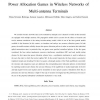Free Online Productivity Tools
i2Speak
i2Symbol
i2OCR
iTex2Img
iWeb2Print
iWeb2Shot
i2Type
iPdf2Split
iPdf2Merge
i2Bopomofo
i2Arabic
i2Style
i2Image
i2PDF
iLatex2Rtf
Sci2ools
CORR
2010
Springer
2010
Springer
Power Allocation Games in Wireless Networks of Multi-antenna Terminals
We consider wireless networks that can be modeled by multiple access channels in which all the terminals are equipped with multiple antennas. The propagation model used to account for the effects of transmit and receive antenna correlations is the unitary-invariant-unitary model, which is one of the most general models available in the literature. In this context, we introduce and analyze two resource allocation games. In both games, the mobile stations selfishly choose their power allocation policies in order to maximize their individual uplink transmission rates; in particular they can ignore some specified centralized policies. In the first game considered, the base station implements successive interference cancellation (SIC) and each mobile station chooses his best space-time power allocation scheme; here, a coordination mechanism is used to indicate to the users the order in which the receiver applies SIC. In the second framework, the base station is assumed to implement single-...
| Added | 09 Dec 2010 |
| Updated | 09 Dec 2010 |
| Type | Journal |
| Year | 2010 |
| Where | CORR |
| Authors | Elena Veronica Belmega, Samson Lasaulce, Mérouane Debbah, M. Jungers, Julien Dumont |
Comments (0)

